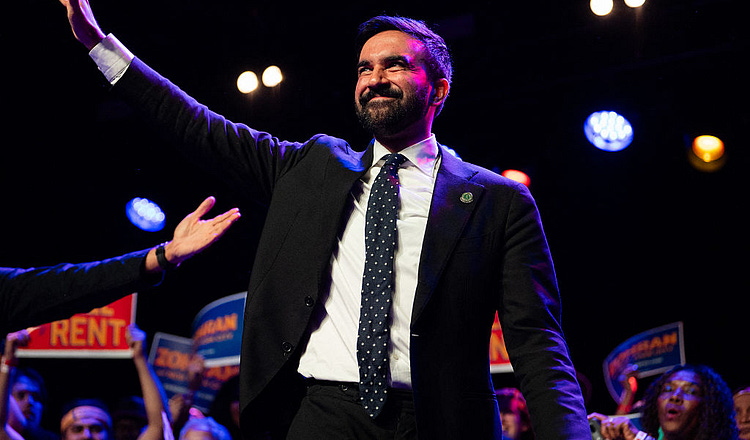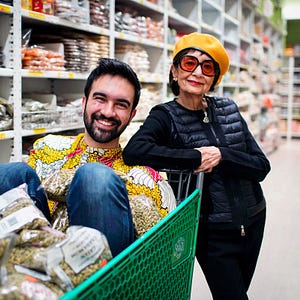
The Free Press

A new poll out this week shows what many have long suspected: The New York mayor’s race is closer than it seems. The survey shows former New York governor Andrew Cuomo leading the pack with 40 percent of the vote, but Zohran Mamdani, a self-described socialist, is not far away at 27 percent.
Just a week earlier, another poll, which had a much larger sample size, put Cuomo 32 points ahead. But a tightening race isn’t the only alarm bell in the survey for the man many expected to glide to victory in this election. The other is what happens when New York’s convoluted ranked-choice voting system is factored in.
Allow me to explain.
From June 14 to June 24, Democratic voters will head to the polls and list their top five candidates out of a crowded pool of 11. In past cycles, the candidate with the most votes would win outright. But since 2021, the winner has been chosen by a system called ranked-choice voting. It means that a candidate has to earn at least 50 percent of votes to win. If no one does so in the first round, the last-place candidate is eliminated, and their votes are redistributed to each voter’s next preference. This process repeats—round by round—until one candidate crosses the 50 percent threshold.
The latest survey, which was commissioned by the Mamdani campaign, shows Cuomo coming out on top, but only in the seventh round, by a margin of 56 to 44.
The whole idea of this system was to find common ground. Stu Loeser, a veteran Democratic strategist, told me ranked-choice voting was sold to New Yorkers by left-of-center advocacy groups as a way to elevate “less flashy, more centrist” candidates. In 2021, he said, the system did just that, when Mayor Eric Adams, a moderate who opposed the defund the police movement, won the Democratic nomination after a whopping seven rounds of vote-counting in a crowded field.
“We’ve only done this once before, and the system elected the most moderate candidate,” said Loeser, who previously served as the press secretary to former mayor Michael Bloomberg.
Not so this time around.
“All the polls from every side indicate that Cuomo is likely to get to 50 percent in the first two or three rounds,” he said. “But ranked-choice voting makes it easier for voters who have an agenda to stop Cuomo.” Loeser says it may “very well be that the system benefits Mamdani.”
An informal progressive coalition is already forming, determined to use ranked-choice voting to block Cuomo.
In late March, the Working Families Party endorsed a slate of four candidates: Mamdani, New York City comptroller Brad Lander, New York state senator Zellnor Myrie, and Adrienne Adams, the speaker of the City Council. The party has been clear that this is a strategy to defeat Cuomo, whom it has said is “unfit to lead because of his abuses of power and serial sexual harassment.”
“This year is not about crawling into our corners,” the party wrote in campaign literature. “It’s about using ranked-choice voting to consolidate the power of our collective vote.”
Hank Sheinkopf, a longtime Democratic strategist in New York, says that ranked-choice voting has the potential to elevate Mamdani, an anti-Israel activist who vows to open government-run grocery stores and whose plan to make New York City more affordable would cost $100 billion, only slightly less than the entire size of this year’s city budget.
“It helps him,” said Sheinkopf, who has previously advised President Bill Clinton and Mayor Bill de Blasio. “And if he wins the primary, it’s the end of New York.”
In 2019, when ranked-choice voting passed with 73 percent of the vote, advocates claimed the system would increase “voter choice” and move “the political conversation more to the center.”
This time, by boosting Mamdani, it could have the opposite effect.
Mamdani, whose first foray into politics was founding a chapter of Students for Justice in Palestine at Bowdoin College, an $86,320 a year institution, has made a name for himself around town with his knack for viral videos and his hip anti-Israel politics. His backers include Ella Emhoff, the 25-year-old stepdaughter of former vice president Kamala Harris; radical “anti-capitalist” Twitch streamer Hasan Piker; and failed gubernatorial candidate Cynthia Nixon. He is running a highly coordinated campaign that recently encouraged his supporters to donate to City Council Speaker Adrienne Adams, as his campaign has already maxed out the fundraising cap at $8 million in donations. A Democratic strategist working for a competing campaign—neither Adams’ nor Mamdani’s—told me that this was likely a strategy for Mamdani to “get as many of the other candidates to say they’re going to rank him second as possible.”
When I asked the strategist whether ranked choice could help elevate Mamdani, whose campaign in previous interviews with The Free Press struggled to answer if Israel has the right to exist, they paused.
“It probably will,” they replied. “But it’s an open question. He has a base that doesn’t put him down for a lot of twos and threes.”
What they mean is that a radical candidate like Mamdani has a devoted group of supporters who will pick him as their first choice, but that he may struggle to pick up second- or third-place votes. This is backed up by a Marist poll from earlier this month, which showed that in the first round, Mamdani picked up 22 percent of voters. In the second round of vote counting, the poll showed his support ticking up only one point—to 23 percent—after votes for the lowest-performing candidates were redistributed. When I asked the Democratic strategist if ranked-choice voting could help close that gap—of Cuomo leading Mamdani by 32 points—they were skeptical.
“If that’s how the race goes, it doesn’t really matter how many second-place votes Zohran will get,” they said.
Their point is that Cuomo, by their estimation, is likely to pick up enough second- and third-place votes to easily reach the 50 percent threshold that would call the race in his favor.
Tony Melone, president of the New Kings Democrats, is one of the Democrats hoping that with proper planning, his group can help block Cuomo’s candidacy. The organization, originally founded by “Brooklyn for Barack” volunteers in 2008, endorsed Mamdani, along with three other candidates, because they figured a coalition was the best way to block the former governor, whom Melone called “another failed leader.”
“We feel like showing voters that there are four excellent options they can rank on their ballot is really our best shot at getting someone better,” said Melone, who has lived in Brooklyn since 2007. His group has endorsed the same slate of candidates as the Working Families Party.
He said this was a strategy the group had devised based on their displeasure with the last election in 2021, when progressive Kathryn Garcia came within one percentage point of defeating moderate Eric Adams—and might have won with a small boost in second- and third-choice votes.
“We’re trying to learn from that lesson and educate voters that if you really want to use all your voting power, you should rank all the candidates that you feel positive about,” he explained. “And you should not rank any candidates that you would not want anywhere near the mayor’s office.”
Ranked-choice voting isn’t the only wild card factor in this race.
John Ketcham of the Manhattan Institute—a lifelong resident of Astoria, Queens—told me that this mayor’s race won’t come down to just the Democratic primary.
“The general election is actually going to be competitive this year for the first time since 1969,” said Ketcham, who directs the conservative think tank’s Cities division.
He pointed out that Eric Adams, who has declared his run as an independent, will be on the general election ballot no matter what, as will Cuomo, who is slated to appear under the newly created “Fight and Deliver” line, even if ranked-choice voting crushes his bid for the Democratic primary next month.
“After the Democratic primary ends, the general election will begin with a sitting mayor against a former governor and potentially a far-left socialist,” he said. “You really have the makings of a fascinating rest of the year here.”




